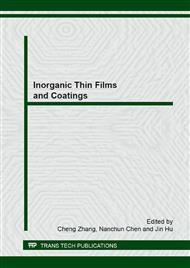[1]
K.L. Chopra, P.D. Paulson, V. Dutta, Thin films solar cells: an overview, Prog. Photovolt: Res. Appl. 92 (2004) 69-92.
DOI: 10.1002/pip.541
Google Scholar
[2]
N. Cherepy, G. Smestad, M. Grätzel, J. Zhang, Ultrafast electron injection: implications for a photoelectrochemical cell utilizing an anthocyanin dye-sensitized TiO2 nanocrystalline electrode, J. Phys. Chem. B 101 (1997) 9342-9351.
DOI: 10.1021/jp972197w
Google Scholar
[3]
A. de Graaf, J. van Deelen, P. Poodt, T. van Mol, K. Spee, F. Grob, A. Kuypers, Development of atmospheric pressure CVD processes for high quality transparent conductive oxides, Energy Procedia 2 (2010) 41-48.
DOI: 10.1016/j.egypro.2010.07.008
Google Scholar
[4]
Y. Muto, N. Oka, N. Tsukamoto, Y. Iwabuchi, H. Kotsubo, Y. Shigesato, High-rate deposition of Sb-doped SnO2 films by reactive sputtering using the impedance control method, Thin Solid Films 520 (2011) 1178-1181.
DOI: 10.1016/j.tsf.2011.04.151
Google Scholar
[5]
S-m. Liu, W-y. Ding, W-p. Chai, Influence of Sb doping on crystal structure and electrical property of SnO2 nanoparticles prepared by chemical coprecipitation, Physica B 406 (2011) 2303-2307.
DOI: 10.1016/j.physb.2011.03.065
Google Scholar
[6]
H. Deng, J. Kong, P. Yang, Optical and structural characteristics of Sb-doped SnO2 thin films grown on Si (111) substrates by Sol-Gel technique, J. Mater. Sci.: Mater. Electron. 20 (2009) 1078-1082.
DOI: 10.1007/s10854-008-9829-4
Google Scholar
[7]
Y. Fu, Z. Jin, Y. Ni, H. Du, T. Wang, Microstructure, optical and optoelectrical properties of mesoporous nc-TiO2 films by hydrolysis-limited sol – gel process with different inhibitors, Thin Solid Films 517 (2009) 5634-5640.
DOI: 10.1016/j.tsf.2009.02.030
Google Scholar
[8]
A. Apolinar-Uribe, M. C. Acosta-Enriquez, M. A. Quevedo-Lopez, R. Ramirez-Bon, A. De Leon, S. J. Castillo, Acetylacetone as complexing agent for CdS thin films grow chemical bath deposition, Chalcogenide Letters 8 (2011) 77-82.
Google Scholar
[9]
A. de Leon, M. C. Acosta-Enríquez, A. F. Jalbout, A. Apolinar-Iribe, S. J. Castillo, The role of tautomerization in acetylacetone as a complexing agent: Theoretical perspectives, Journal of Molecular Structure: THEOCHEM 957 (2010) 90-93.
DOI: 10.1016/j.theochem.2010.07.013
Google Scholar
[10]
L. Weng, X. Bao, K. Sagoe-crentsil, Effect of acetylacetone on the preparation of PZT materials in sol-gel processing, Mat. Sci. Eng. B 96 (2002) 307-312.
DOI: 10.1016/s0921-5107(02)00384-7
Google Scholar
[11]
M. Guglielmi, E. Menegazzo, S. Materiali, M. Paolizzi, I. G. Spa, G. Gasparro, D. Ganz, J. P. Utz, M. A. Aegerter, I. Stadtwald, C. Pascual, A. Duran, H. X. Willems, M. VAN Bommel, L. B. Uttgenbach, L. Costa, Sol-Gel Deposited Sb-Doped Tin Oxide Films, J. Sol-gel Sci. Technol. 683 (1998) 679-683.
DOI: 10.1023/a:1008636804449
Google Scholar
[12]
Y. Li, R. M. Almeida, Elimination of porosity in heavily rare-earth doped sol–gel derived silicate glass films, J. Sol-gel Sci. Technol. 61 (2011) 332-339.
DOI: 10.1007/s10971-011-2632-3
Google Scholar
[13]
T. R. Giraldi, M. T. Escote, M. I. B. Bernardi, V. Bouquet, E. R. Leite, E. Longo, J. A. Varela, Effect of Thickness on the Electrical and Optical Properties of Sb Doped SnO2 (ATO) Thin Films, J. Electroceram. 13 (2004) 159-165.
DOI: 10.1007/s10832-004-5093-z
Google Scholar
[14]
D. Zhang, L. Tao, Z. Deng, J. Zhang, L. Chen, Microstructure and electrical properties of antimony-doped tin oxide thin film deposited by sol-gel process, Mat. Chem. Phys. 100 (2006) 275-280.
DOI: 10.1016/j.matchemphys.2005.09.038
Google Scholar
[15]
Y-J. Lin, C-J. Wu, The properties of antimony-doped tin oxide thin films from the sol-gel process, Surf. Coat. Technol. 88 (1996) 239-247.
DOI: 10.1016/s0257-8972(96)02926-x
Google Scholar
[16]
W. Hamd, A. Boulle, E. Thune, R. Guinebretiere, A new way to prepare tin oxide precursor polymeric gels, J. Sol-gel Sci. Technol. 55 (2010) 15-18.
DOI: 10.1007/s10971-010-2206-9
Google Scholar
[17]
E. Elangovan, K. Ramamurthi, Studies on optical properties of polycrystalline SnO2: Sb thin films prepared using SnCl2 precursor, Crys. Res. Technol. 784 (2003) 779-784.
DOI: 10.1002/crat.200310095
Google Scholar
[18]
M. Vishwas, K. Narasimha Rao, K. V. Arjuna Gowda, R. P. S. Chakradhar, Effect of sintering on optical, structural and photoluminescence properties of ZnO thin films prepared by sol-gel process, Spectrochimica acta A, Mol. and Biomol. Spectroscopy 77 (2010) 330-333.
DOI: 10.1016/j.saa.2010.04.032
Google Scholar
[19]
K. Ravichandran, P. Philominathan, Fabrication of antimony doped tin oxide ( ATO ) films by an inexpensive, simplified spray technique using perfume atomizer, Mat. Lett. 62 (2008) 2980-2983.
DOI: 10.1016/j.matlet.2008.01.119
Google Scholar
[20]
H. Bisht, H-T. Eun, A. Mehrtens, M. Aegerter, Comparison of spray pyrolyzed FTO, ATO and ITO coatings for flat and bent glass substrates, Thin solid films 351 (1999) 109-114.
DOI: 10.1016/s0040-6090(99)00254-0
Google Scholar


